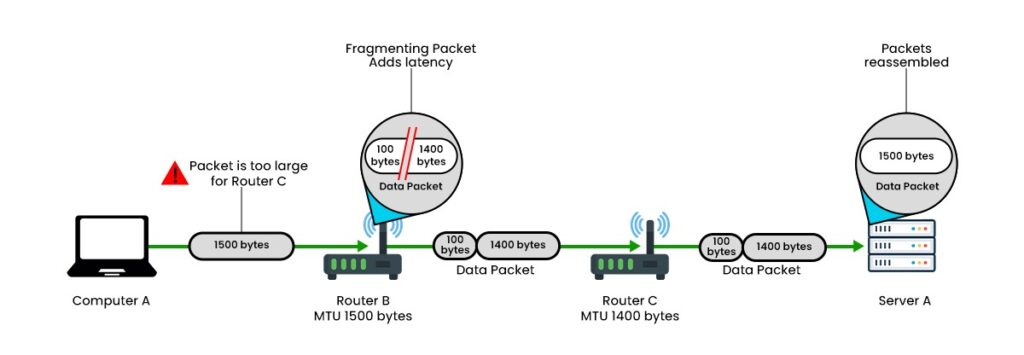Introduction
If you are interested in computer networking, you might have heard of MTU and MSS. But what they really are and why one should study these concepts in detail. MTU and MSS are important concepts as they help determine the size of each packet sent across the network without getting into the fragmentation phase.
Understanding the difference between MTU and MSS not only enables you to optimize the network performance but also assists in avoiding unnecessary data loss. In this blog, we will look into MSS vs MTU, and we will also explain both in detail.
Difference between MTU and MSS
The main difference between MTU and MSS is that MTU denotes the maximum size of a packet of the network layer, including headers, while MSS denotes maximum size of a segment of the transport layer without IP and TCP headers. Below we have explained more differences between MSS and MTU in a tabular form.
| Factors | MTU | MSS |
|---|---|---|
| Definition | MTU stands for Maximum Transmission Unit. | MSS stands for Maximum Segment Size. |
| Protocol | MTU is a link layer parameter that is dependent on both the network layer protocol and the physical media. It contains both the TCP and IP headers. | A TCP option called MSS is negotiated as part of the handshake. The IP header and the TCP header are not included. |
| Fragmentation | Fragmentation is allowed by MTU. | MSS prohibits fragmentation. |
| Formula | MTU = MSS + 40 (IP header + TCP header) | MSS = MTU – 40 (IP header + TCP header) |
| Value | 1500 bytes | 1460 bytes |
| Dependency | MTU size does not rely on the value of MSS. | MSS size totally depends on the value of the underlying MTU. |
Before getting into more details of MTU vs MSS, let’s first understand what MTU and MSS really are.
What is MTU in Networking?
MTU, or maximum transmission unit, is the largest frame or packet size that can be sent as a single entity from the source to the destination in a network at a given point in time. The underlying network technology determines the MTU; some of these are Ethernet, ATM, or PPP.
When we talk about MTU value, it’s the maximum size under which a packet can be sent. For example, when we talk about Ethernet, it is 1500, and for PPP, it is 1492. Most of the time, the sender node sets the MTU value. Value is set in a way that can match the capacity of the host node in the network to send or receive single packets at a given time. The optimal value of MTU depends on various factors, some of which are bandwidth, reliability, and the error rate of the network link.
Now, the question arises: what will happen if the packet exceeds the MTU value?
In such a case, the packet is broken into smaller pieces, also known as fragments, either by the sender or any intermediate device. Each fragment has its own header that contains information about the original packet. The fragments are then reassembled at the receiver end. For better understanding, we have shown the image below.

There are some drawbacks to breaking down the packet into small fragments. One of many is it can reduce network efficiency. It can also cause errors or loss of data if, by chance, the fragments get lost or corrupted during the transmission process.
The formula for calculating MTU is MTU = MSS + 40 (IP header + TCP header)
Why is MTU Important?
- Prevents Fragmentation: If the MTU is too small, large packets will be broken into smaller fragments, increasing overhead and reducing performance.
- Affects Network Performance: A higher MTU can improve efficiency by reducing the number of packets needed to transmit data, but it must be supported by all network devices.
- Determines Packet Size: MTU dictates the maximum size of each transmitted packet at the network layer.
How MTU Works?
As soon as a device sends information, it studies the MTU value of the interface. When the packet goes above this size, it is broken down into packets which are smaller for transmission. However, in TCP/IP Networks, fragmentation is prohibited by the use of PMTUD, which dynamically discovers the best MTU size during operation.
Let’s understand MSS in detail.
What is MSS in Networking?
MSS, or maximum segment size, is the largest amount of data or packet that can be sent from source to destination in a single TCP segment. It is one of the important factors that can impact the TCP performance. A TCP segment is nothing but a unit of data that is being transmitted over a TCP connection. It consists of two parts, namely, header and payload. The header contains information about the source and destination port numbers, ack numbers, and many other crucial information. At the same time, the payload contains the actual data that is to be transmitted.
MSS can be negotiated while TCP handshake. In this process, each host sends its own MSS value with a SYN message in an option field. Here, the MSS value represents the maximum size of data that the host can accept in a single TCP segment. It does not include a TCP header. The final MSS value is decided based on the minimum two values exchanged by the hosts.
In a case where the TCP segment is higher than the MSS value, it cannot be transmitted. It will be discarded, and requests for the retrains mission of the data with a smaller size. As a result, this will reduce the efficiency of data transmission.
The optimal value of MSS depends on several factors, such as the MTU of the network path, the TCP options used, and the application requirements.
The formula for calculating MSS is: MSS = MTU – 40 (IP header + TCP header)
Why is MSS Important?
- Improves The Efficiency Of The Data Transfer: Reduces the level of fragmentation, ensuring space on the packet is effeciently utilized.
- Avoids Packet Fragmentation: Since MSS considers header sizes, it helps prevent breaking data into smaller pieces.
- Improves TCP Performance: Correct MSS values ensure smoother data flow across the network.
How MSS Works?
When establishing a TCP connection, both the relaying device and the ready device shift their MSS values using the TCP three-way handshake. The lowest MSS value is used to prevent packet fragmentation.
Let’s move on to understanding the difference between MTU and MSS.
MTU vs MSS – What’s the Difference?
We have compared MTU vs MSS on various parameters below:
Definition
MTU is the maximum size of an IP packet, headers and payload included. MSS is the maximum size of the data inside a TCP segment without headers.
Layer of Operation
MTU works on layer three which is the network layer. MSS works on layer four which is the transport layer.
Header Inclusion
MTU includes both the IP and the TCP/UDP headers. MSS only includes the TCP payload (actual data) thus not including the headers.
Default Values
The MTU value is usually 1500 bytes for Ethernet. MSS value is standard MTU minus 40 bytes, which translates to 1460 bytes for Ethernet.
Fragmentation Handling
MTU fragmentation happens at the network layer. MSS prevents TCP segment fragmentation by ensuring data fits within the MTU.
These are the main difference between MTU and MSS.
Which One is More Important – MTU or MSS?
Both are Important, but MSS is more important for TCP-based communications because it directly impacts how much data can be sent in a single segment without fragmentation. A properly configured MSS value ensures efficient data transfer without causing network slowdowns due to excessive fragmentation.
However, MTU is essential for the entire network, as it affects all protocols, including TCP, UDP, and ICMP. If MTU is misconfigured, it can cause connectivity issues, such as slow speeds, packet loss, or dropped connections.
Frequently Asked Questions
Q1. Is MTU the same as MSS?
MTU is the maximum size of a packet, including headers. MSS is the maximum size of the data part only. They are related but not the same.
Q2. Can MSS be greater than MTU?
MSS is less than MTU as it does not include TCP/IP header data.
Q3. What is the TCP MSS for 1500 MTU?
TCP MSS for 1500 MTU is 1460 bytes, as the TCP header and IP header are 20 bytes each.
Q4. How do you calculate MSS from MTU?
You can use the formula for calculating the MSS from MTU, i.e., MSS = MTU – 40 (IP header + TCP header)
Conclusion
Understanding the difference between MTU and MSS is crucial for optimizing network performance. MTU determines the maximum packet size that can be transmitted over a network, including headers, while MSS defines the maximum TCP payload size, excluding headers. A well-configured MTU and MSS help prevent fragmentation, improve data transmission efficiency, and ensure smooth network operations.





